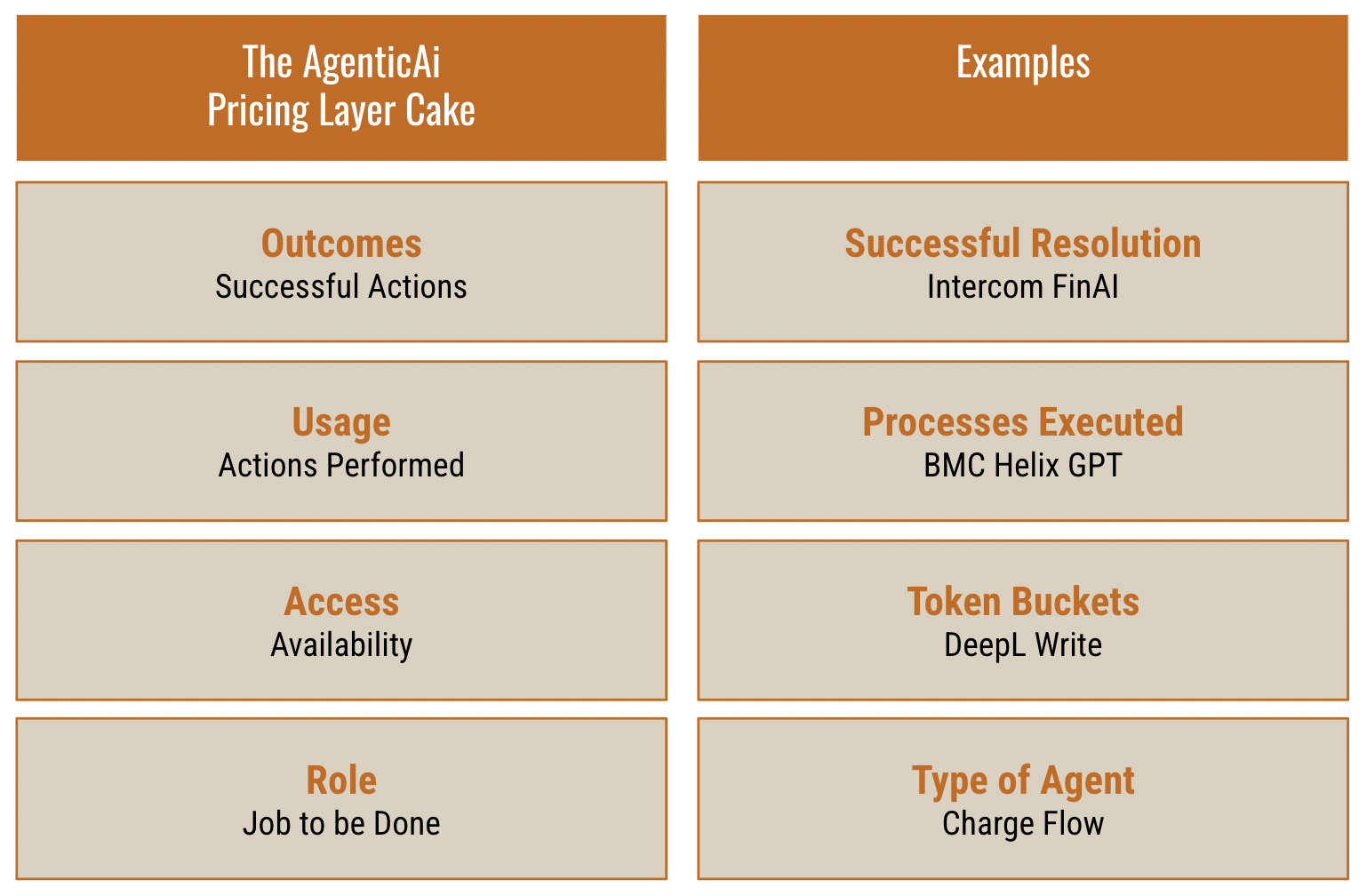How to price AI agents
Steven Forth is CEO of Ibbaka. Connect on LinkedIn
Pricing AI agents is one of the big challenges facing the software industry as we move from the subscription economy to the agent economy
Two approaches to agent pricing emerged in April 2025. Growth Unhinged published a 2x2 matrix to organize pricing models being seen in the market. Earlier the same week, Ibbaka published its AI Agent Pricing Layer Cake, defining four approaches to pricing AI Agents.
Growth Unhinged - Pricing AI Agent Models
The Growth Unhinged approach defines a Y-Axis contrasting Activity Based Pricing with Outcome Based Pricing and an X-Axis contrasting Fixed vs. Variable pricing. This gives four modes of AI Agent Pricing.
See A New Framework for AI Agent Pricing by Manny Medina on Growth Unhinged.
The Growth Unhinged AI Model Pricing Matrix first published April 8, 2025.
Per agent - the FTE replacement model
Per agent action - the consumption model
Per workflow executed - the process automation mode
Per agent outcome - the results-based model
Ibbaka AI Agent Pricing Layer Cake
The Agentic AI Pricing Layer Cake is a structured framework that organizes pricing metrics for AI agents into four layers. This layered approach simplifies pricing design by categorizing metrics according to their relationship to value delivery and customer engagement. By understanding these layers, organizations can create pricing models that balance complexity with effectiveness. Ibbaka introduced this in a post on this blog in Pricing the Agent Economy.
The Ibbaka AI Agent Pricing Layer Cake first published April 7, 2025.
This approach anticipates that many agents will have two or, in some cases, three pricing metrics (hopefully not four). Some agents will be priced using just one layer of the layer cake, but in many cases, there will be hybrid pricing. The following combinations are the most likely. They are also the combinations that are likely to best track the value the agent provides.
Role + Access: The retainer model. If computing becomes an issue, some buyers will want to reserve priority access to certain types of agents.
Role + Usage: The role defines the job to be done, and the usage measures the number of times the agent is asked to do the job.
Role + Outcomes: This is like the contingency fee that lawyers get paid for some lawsuits.
Access + Outcomes: Access fees provide some predictability while the outcome payment rewards success.
Usage + Outcomes: The agent will charge each time it is used and will add an additional payment for a successful outcome.
Outcomes based pricing is most feasible for agents that meet the following three criteria:
The outcome is clear, measurable, and can be agreed on
The agent's contribution to the outcome is clear (attribution)
The outcomes are predictable (this helps make cost predictable for the buyer and revenue predictable for the seller)
Most agents will not be able to meet these three criteria, so the most common agent pricing patterns are likely to be Role + Access (if assured access to compute is an issue) and Role + Usage (which will be the dominant model for most AI agents).
Applying these approaches to credits
One of the trending approaches to pricing generative AI and AI applications is using credit buckets. See Why tokens and credits are becoming a standard approach to pricing AI solutions.
How can these frameworks be applied to the design of credit pricing for AI agents?
The two frameworks offer complementary perspectives that can be integrated to design effective credit-based pricing systems for AI agents:
Strategic Positioning Using the Growth Unhinged Matrix
The Growth Unhinged matrix provides strategic clarity by forcing companies to decide:
Is their primary value creation role activity-based or outcome-based?
Should pricing be fixed or variable?
This initial positioning helps determine the fundamental nature of the credit system. For instance, a company might position its agent primarily in the "Per Agent Action" quadrant (variable, activity-based), but with elements from the "Per Agent Outcome" quadrant to reward successful results.
Tactical Design Using the Ibbaka Layer Cake
Once strategically positioned, the Ibbaka Layer Cake offers tactical flexibility for designing the specific components of the credit system:
Role + Usage: Define credit consumption rates based on the specific role of the agent, with different credit values for different types of tasks
Usage + Outcomes: Implement credit bonuses or rebates when agents achieve specific outcomes
Role + Access + Usage: Create tiered credit packages with different access priorities based on the agent's role
Implementation Considerations for Credit Systems
Several key considerations emerge from combining these frameworks:
Credit Denomination: Define whether credits represent tokens, time, actions, or complex operations
Credit Bundles vs. Pay-as-you-go: Determine whether to offer fixed credit packages or allow variable consumption
Credit Expiration: Set policies on whether credits expire or roll over, influencing purchasing behavior
Credit Conversion Rates: Establish different rates for different types of agent activities or outcomes
Credit Discounting: Implement volume discounts or outcome-based credit refunds
Given the compelling reasons to price AI agents using credits, we are going to need to develop good design processes and patterns for this work.




